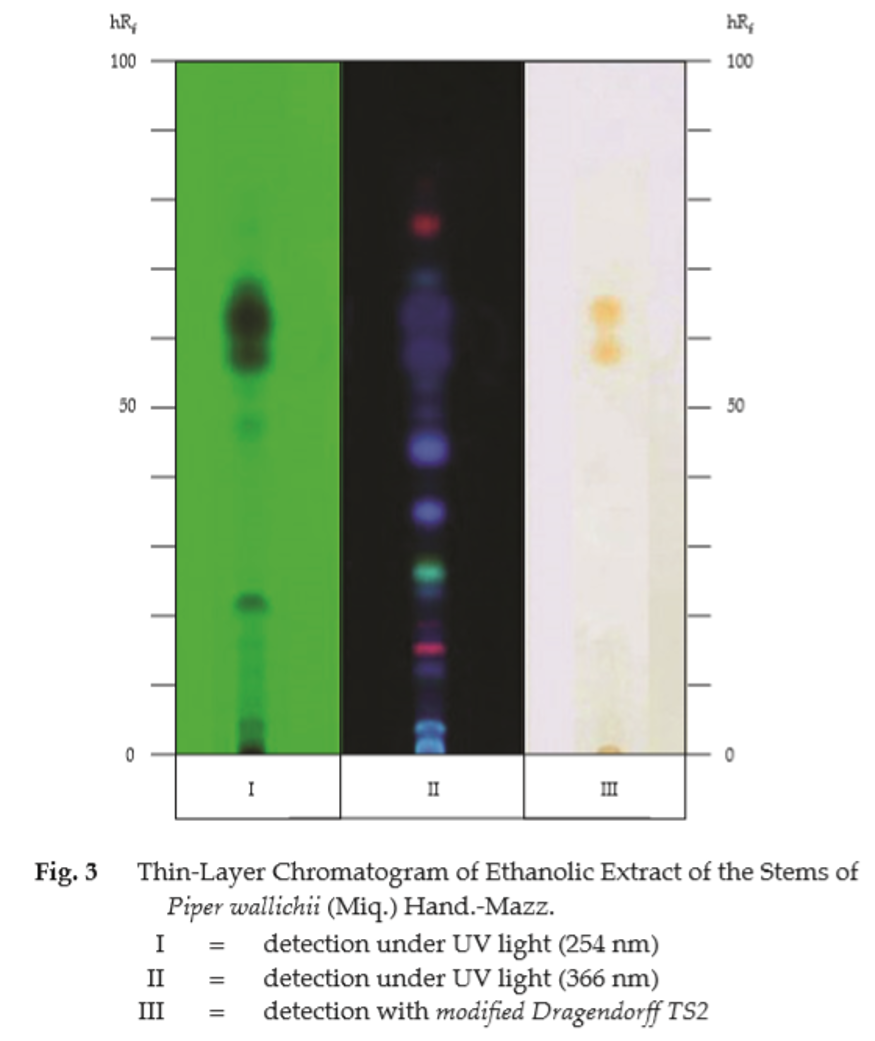ตำรามาตรฐานยาสมุนไพรไทย
Thai Herbal Pharmacopoeia
สำนักยาและวัตถุเสพติด กรมวิทยาศาสตร์การแพทย์ กระทรวงสาธารณสุข
Bureau of Drug and Narcotic, Department of Medical Sciences, Ministry of Public Health(Tinospora crispa (L.) Hook.f. & Thomson)
(Nelumbo nucifera Gaertn.)
(Centella asiatica (L.) Urb.)
(Centella Dry Extract)
(Centella Cream)
(Mesua ferrea L.)
(Piper sarmentosum Roxb.)
(Piper sarmentosum Roxb.)
(Pterocarpus santalinus L. f.)
(Santalum album L.)
(Senna tora (L.) Roxb.)
(Senna alata (L.) Roxb.)
(Senna Alata Tea)
(Piper retrofractum Vahl)
(Myristica fragrans Houtt)
(Andrographis paniculata (Burm. f.) Nees)
(Andrographis Capsules)
(Allium ascalonicum L.)
(Ocimum tenuiflorum L.)
(Curcuma longa L.)
(Turmeric Capsules)
(Turmeric Dry Extract)
(Turmeric Dry Extract Capsules)
(Arcangelisia flava (L.) Merr.)
(Curcuma sp.)
Harrisonia perforata (Blanco) Merr.
(Aristolochia pierrei Lecomte)
(Zingiber officinale Roscoe)
(Ginger Capsules)
(Ginger Tea)
(Cassia fistula L.)
(Nardostachys jatamansi (D. Don) DC.)
(Angelica sinensis (Oliv.) Diels)
Artemisia annua L.
(Ligusticum sinense Oliv. cv. Chuanxiong)
(Neopicrorhiza scrophulariiflora Pennell)
(Atractylodes lancea (Thunb.) DC.)
(Aucklandia lappa Decne)
(Terminalia chebula Retz.)
(Angelica dahurica (Hoffm.) Benth. & Hook. f. ex Franch. & Sav. var. dahurica)
(Kaempferia parviflora Wall. ex Baker)
(Hibiscus sabdariffa L.)
(Roselle Tea)
(Allium sativum L.)
(Zingiber zerumbet (L.) Sm.)
(Wurfbainia testacea (Ridl.) Škorničk.& A. D. Poulsen)
(Cannabis sativa L.)
(Myristica fragrans Houtt)
(Dracaena cochinchinensis (Lour.) S. C. Chen)
(Ficus racemosa L.)
(Hyptis suaveolens (L.) Poit.)
Clerodendrum indicum (L.) Kuntze
(Phyllanthus emblica L.)
(Citrus hystrix DC.)
(Citrus hystrix DC.)
(Areca catechu L.)
(Momordica charantia L.)
Moringa oleifera Lam.
(Aegle marmelos (L.) Corrêa)
(Solanum trilobatum L.)
(Morus alba L.)
Gynostemma pentaphyllum(Thunb.)
Makino
(Clinacanthus nutans (Burm. f.) Lindau)
(Cissus quadrangularis L.)
(Mimusops elengi L.)
(Zingiber montanum (J. König) Link. ex A. Dietr.)
(Piper betle L.)
(Capsicum annuum L.)
(Capsicum Oleoresin)
(Capsicum Gel)
(Piper nigrum L.)
(Piper nigrum L.)
(Eurycoma longifolia Jack)
(Thunbergia laurifolia Lindl.)
(Piper wallichii (Miq.) Hand.-Mazz.)
Senna garrettiana (Craib) H. S. Irwin & Barneby
(Terminalia bellirica (Gaertn.) Roxb.)
(Terminalia chebula Retz.)
(Caesalpinia bonduc (L.) H. Roxb.)
(Tarlmounia elliptica (DC.) H. Rob., S. C. Keeley, Skvaria & R. Chan)
(Hog Creeper Vine Dry Extract Capsiles)
(Hog Creeper Vine Dry Extract)
(Brachypterum scandens (Roxb.) Miq.)
(Lepidium sativum L.)
(Nigella sativa L.)
(Cuminum cyminum L.)
(Foeniculum vulgare Mill.)
(Plantago ovata Forssk.)
(Pimpinella anisum L.)
(Carum carvi L.)
(Anethum graveolens L.)
(Trachyspermum ammi (L.) Sprague)
Albizia procera (Roxb.) Benth.
(Acorus calamus L.)
(Tiliacora triandra (Colebr.) Diels)
Cyanthillium cinereum (L.) H. Rob.
(Orthosiphon aristatus (Blume) Miq.)
Murdannia loriformis (Hassk.) R. S. Rao & Kammathy
(Capparis micracantha DC.)
(Chrysopogon zizanioides (L.) Roberty)
(Cyperus rotundus L.)
(Cannabis sativa L.)
(Syzygium aromaticum (L.) Merr. & L. M. Perry)
(Boesenbergia rotunda (L.) Mansf.)
(Acanthus ebracteatus Vahl)
(Acanthus ilicifolius L.)
(Kaempferia galanga L.)
(Curcuma comosa Roxb.)
Betula alnoides Buch.-Ham. ex D. Don
Cannabis sativa L.
Carthamus tinctorius L
Mitragyna speciosa (Korth.) Havil
Mallotus repandus (Rottler) Müll. Arg
Azadirachta indica A. Juss. var. siamensis Valeton
Azadirachta indica A. Juss. var. siamensis Valeton
Punica granatum L.
Rhinacanthus nasutus (L.) Kurz
Baliospermum solanifolium (Burm.) Suresh
Curcuma aeruginosa Roxb
Boesenbergia kingii Mood & L. M. Prince
Senegalia rugata (Lam.) Britton & Rose
Acacia concinna (Willd.) DC.
Senegalia rugata (Lam.) Britton & Rose
Acacia concinna (Willd.) DC.
Senna alexandriana Mill. var. alexandriana
Cassia acutifolia Delile, Cassia angustifolia Vahl
Butea superba Roxb. ex Willd.
[Plaso superba (Roxb. ex Willd.) Kuntze, Rudolphia superba (Roxb. ex Willd.) Poir.
Pueraria candollei Graham
ex Benth. var. mirifica (Airy Shaw & Suvat.) Niyomdham
Streblus asper Lour.
Suregada multiflora (A. Juss.) Baill. (Gelonium
multiflorum A. Juss.
Piper Wallichii Stem is the dried stem of Piper wallichii (Miq.) Hand.-Mazz. (Family Piperaceae), Herbarium Specimen Number: DMSC 5175, 5176, Crude Drug Number: DMSc 0931, 0932.
Constituents Piper Wallichii Stem contains amide alkaloids (e.g., pellitorine), lignans, phenylpropanoids, aromatic glycosides, etc.
Description of the plant (Figs. 1a, 1b) Dioecious woody climber; stem black when dry, ridged, usually hispidulous; node with climbing roots. Leaves simple, alternate, ovate-lanceolate or narrowly elliptic, 5 to 26 cm long, 4 to 17.5 cm wide, apex acute to acuminate, base cuneate or cordate, slightly oblique, margin undulate, blade papery, upper surface dark green, lower surface glaucous, greyish when dry, veins 5 to 7, pinnipalmate; petiole 0.4 to 1 cm long; stipule hairy, oblong-lanceolate. Inflorescence spike, terminal or leaf-opposed, pendulous, yellow or green-yellow, cylindrical; bract spirally arranged, orbicular, about 1 mm in diameter, abaxially pubescent. Male spike 5 to 15 cm long, 3 to 5 mm wide; peduncle up to 2 cm long, puberulous; rachis sparsely pubescent; bract orbicular, 1 to 1.2 mm wide, peltate; male flower with 3 to 4 stamens, filament about 0.4 mm long, anther reniform, about 0.5 mm long; female spike 5 to 7 cm long, 2 to 5 mm wide; peduncle 2 to 4.2 cm long, pubescent; bract as in male spike; female flower with distinct ovary, subglobose, apex pointed, stigma 3- to 4-lobed, 1 to 1.5 mm in diameter. Infructescence pendulous, cylindrical, 10 to 30 cm long, 1 to 2 cm wide; stipe 2 to 4 cm long, puberulous. Fruit drupe, sessile, more or less globose, 3 to 4 mm in diameter, tuberculate, orange to red when ripe, stigma and bract persistent.
Description Odour, aromatic and pungent; taste, pungent and spicy.
Macroscopical (Fig. 1a) Sliced vine, varying in shape, length, width, and thickness; bark, fragile and breakable; externally wrinkled, brown, with numerous raised lenticels; a part of roots may be found in some pieces; internally light brown, with radial lines originated from dark brown ring encircled a light brown core.
Microscopical (Figs. 2a, 2b) Transverse section of the stem shows cork layer, cortex and stele. Periderm, rectangular cork cells and scattered large raised-lenticels. Cortex, round parenchyma cells (some containing starch grains), scattered groups of thick-walled sclereids (with distinct pore canals), and circular layers of thick-walled sclereids, respectively. Stele, anomalous with two regions of vascular tissues, round parenchyma cells with scattered mucilage canals; outer region of vascular tissue, several large strips of vascular bundles and broad-band medullary rays; inner region, small strips of vascular bundles and small bands medullary rays; vascular bundles, ectophloic type; pith, round thin-walled parenchyma cells some containing starch grains and mucilage canals.
Piper Wallichii Stem in powder possesses the diagnostic microscopical characters of the unground drug. Parenchyma containing simple and compound starch grains, numerous large bordered-pitted vessels, and mostly rectangular thick-walled sclereids with distinct pore canals are characteristic.
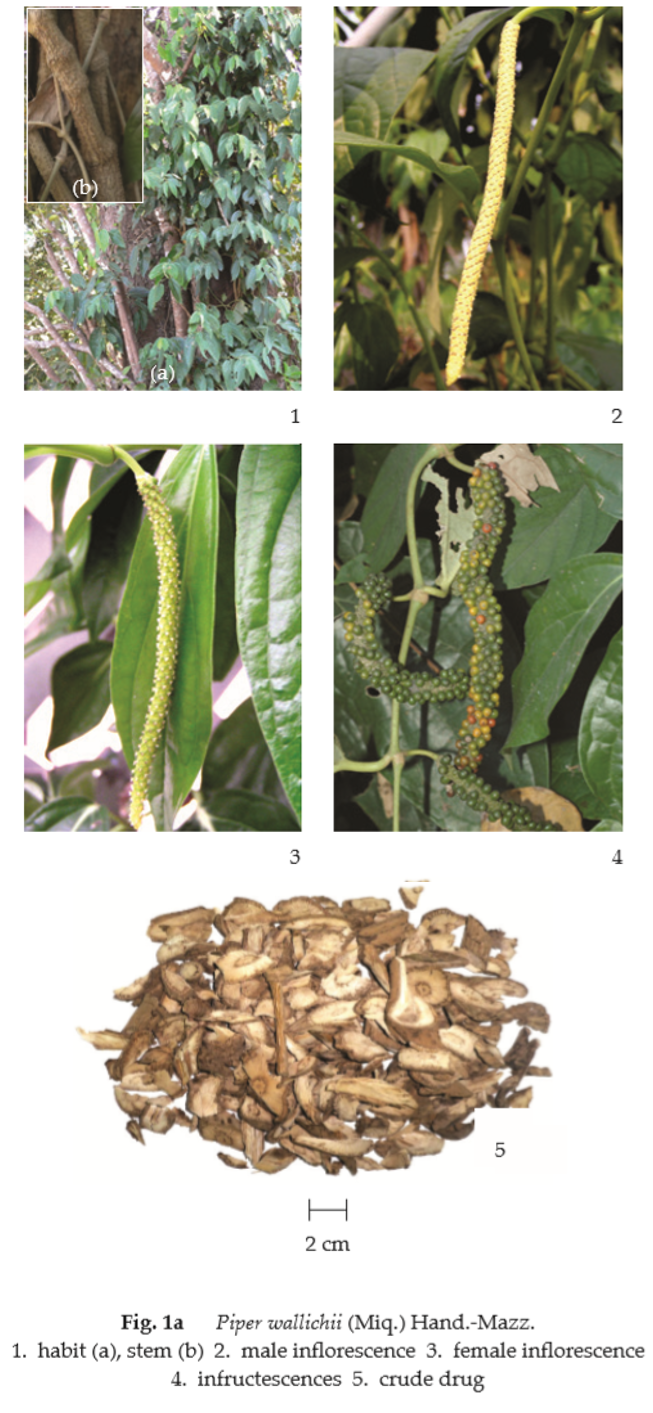
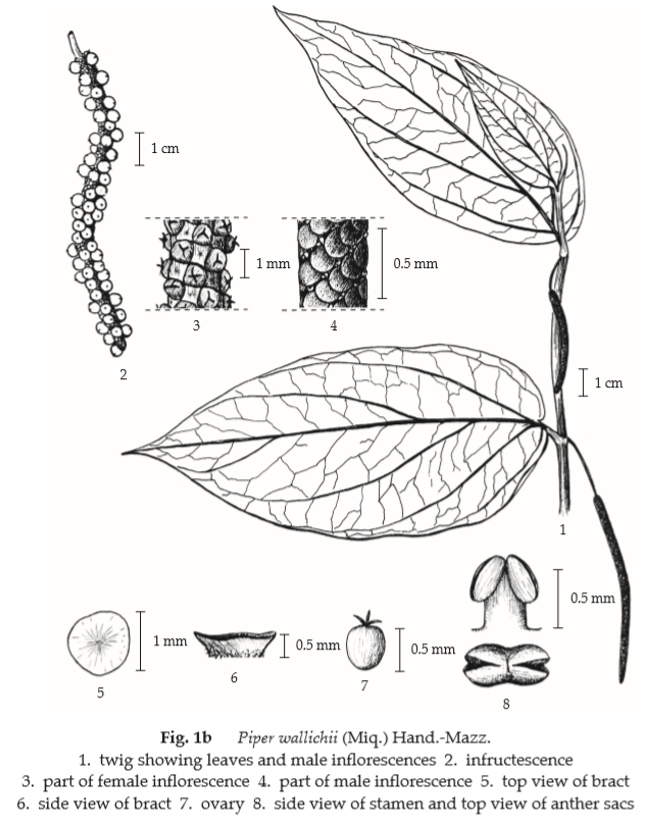
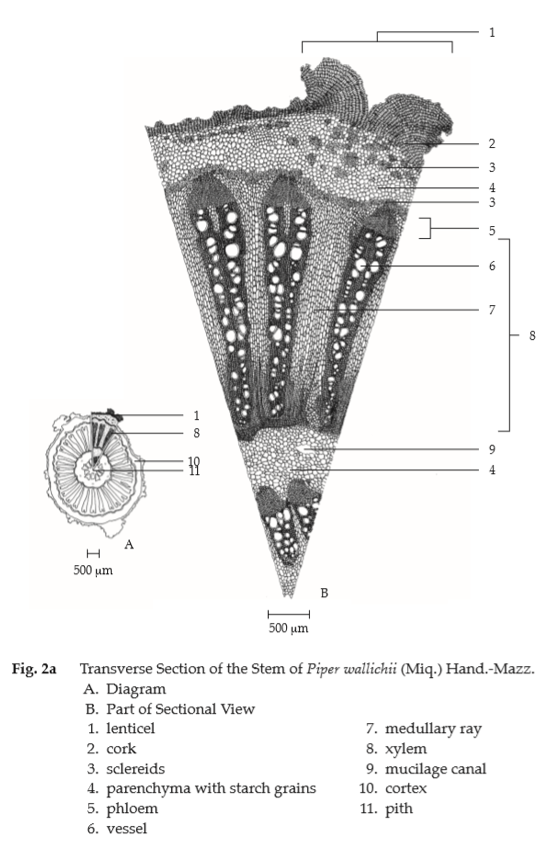
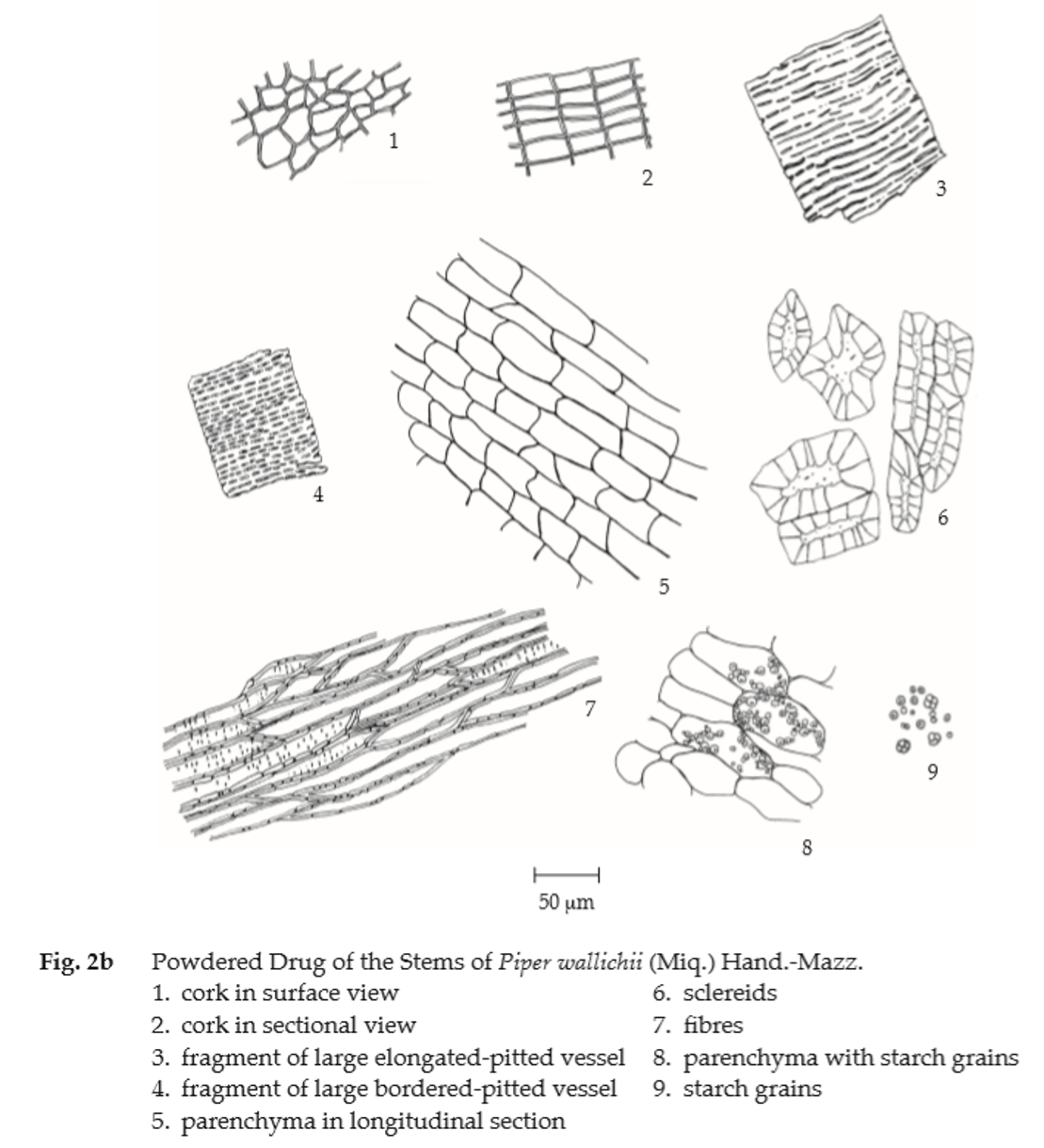
Additional information
1. The crude drug entitled “Sakhan” sold in herbal markets in Thailand may refer to other Piper species. However, Piper wallichii (Miq.) Hand.-Mazz. is cultivated and commercially available in the markets throughout northern Thailand.
2. It is commonly used with other herbal drugs in Thai traditional herbal preparations.
Packaging and storage Piper Wallichii Stem shall be kept in well-closed containers, protected from light, and stored in a dry place.
Identification
A. Reflux 1 g of the sample, in powder, with 20 mL of ethanol on a water-bath for 15 minutes and filter (solution 1). To 1 ml of solution 1, add a few drops of modified Dragendorff TS2: an orange precipitate is produced.
B. Carry out the test as described in the “Thin-Layer Chromatography” (Appendix 3.1), using silica gel GF254 as the coating substance and a mixture of 95 volumes of dichloromethane and 5 volumes of methanol as the mobile phase and allowing the solvent front to ascend 10 cm above the line of application. Apply to the plate, 2 μL of the test solution prepared by evaporating 10 mL of solution 1 to dryness and dissolving the residue in 2 mL of dichloromethane. After removal of the plate, allow it to dry in air and examine under ultraviolet light (254 nm), marking the quenching spots. Subsequently examine the plate under ultraviolet light (366 nm) through the cut-off filter; several fluorescent spots of different colours are observed. Spray the plate with modified Dragendorff TS2. Two orange spots are observed (Table 1); see also Fig. 3.
Table 1 hRf Values of Components in Ethanolic Extract of the Stems of Piper wallichii (Miq.) Hand.-Mazz.
| Spot | hRf Value | Detection | ||
| UV 254 | UV 366 | Modified Dragendorff TS2 | ||
| 1 2 3 4 5 6 7 8 9 10 11 12 13 14 15 |
5-9 13-21 17-24 20-30 23-33 25-35 27-40 35-48 45-57 50-61 53-64 58-70 64-73 69-76 82-83 |
weak quenching - - - quenching - - - - weak quenching - quenching quenching - - |
green-blue blue red light red - blue green blue blue light blue light blue blue blue light blue red |
- - - - - - - - - - - orange orange - - |
Loss on drying Not more than 8.0 per cent w/w after drying at 105° to constant weight (Appendix 4.15).
Foreign matter Not more than 2.0 per cent w/w (Appendix 7.2).
Total ash Not more than 9.0 per cent w/w (Appendix 7.7).
Ethanol-soluble extractive Not less than 6.0 per cent w/w (Appendix 7.12).
Water-soluble extractive Not less than 25.0 per cent w/w (Appendix 7.12).
